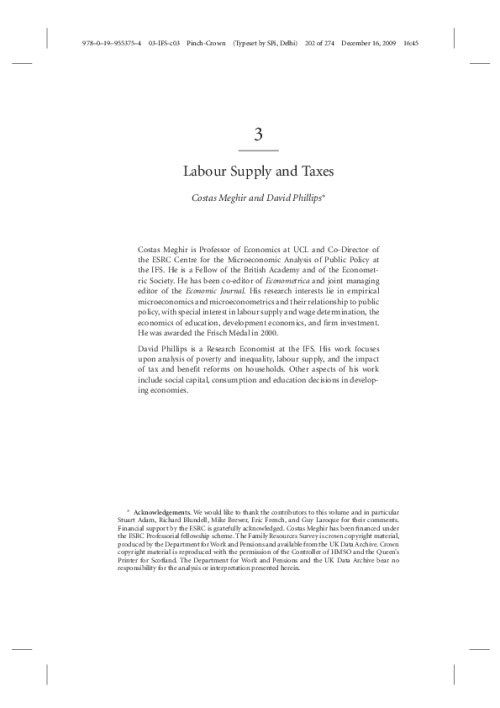This chapter provides an overview of the voluminous literature relating taxand the supply of effort that has developed since the Meade Report (Meade, 1978) on the UK tax system thirty years ago, with a focus on the empirical consensus on how taxes and benefits affect incentives. Our starting point is the traditional view of labour supply, where hours of work and participation in work are the key measures of effort supplied by individuals. We discuss the way that economists think about labour supply conceptually.
We begin by imagining a simple world in which individuals have completely free choice over their hours of work. We then take into account important real-world features of the labour supply choice, including fixed costs associated with working, the complications created by the benefits system, how labour supply choices evolve over time and how decisions take place in the context of the family. We discuss what such thought experiments tell us about the effects of tax reform on work behaviour.
We then discuss the ‘New Tax Responsiveness’ literature which takes a more general view of effort and does not assume that it can be perfectly measured by hours of work supplied. Here the focus is on how people’s taxable income responds to the marginal tax rate they pay on every extra pound earned. This approach recognizes that hours worked are not a very good measure of effort for people with high levels of autonomy on the job and who already work long hours, such as the self employed or senior executives. This literature typically uses a ‘difference-in-differences’ approach, which compares the taxable income of groups affected and not affected by a particular change in the tax system, before and after the change takes place. This leads to several problems because of the impact of temporary changes in income, long-term trends in the income distribution, and the interrelationship between tax changes and pre-tax wages. Unfortunately, it is not clear whether these complicating factors mean that the extent to which labour supply responds to tax changes is overstated or understated. Efforts to take account of these factors are important, but because the specifics of each tax change are different, it is difficult to generalize from any one of them. This can be seen by applying a consistent methodology across the full range of tax reforms in the twentieth century.
Finally, we discuss the impact that taxes and benefits can have on longer-run outcomes which affect standards of living, such as education and training choices. These effects should be taken into account in analysing or designing any tax and benefit system.
After discussing the theory, we summarize the relevant empirical estimates and the methodology underlying the studies. We use this work to formulate an overall view of the responsiveness of labour supply, and place by far the greatest weight on work that avoids relying on unrealistic assumptions about how the world works, but that tries to develop an explicit understanding of the underlying processes at work so that the conclusions can be applied to different circumstances. We consider labour supply as measured by hours worked, the decision to take a job at all, and taxable income.
Our conclusion is that hours of work do not respond particularly strongly to the financial incentives created by tax changes for men, but they are a little more responsive for married women and lone mothers. On the other hand, the decision whether or not to take paid work at all is quite sensitive to taxation and benefits for women and mothers in particular. Within this chapter we present new estimates for both married and single men based on the numerous reforms over the past two decades in the UK. We find that the decision whether or not to work by low education men is somewhat more responsive to incentives than previously thought. For men with high levels of education, the work decision is very unresponsive. The amount of taxable income they earn does seem to be responsive, but more because they shift their income and spending into non-taxable forms than because they reduce their work effort. This is economically costly.










